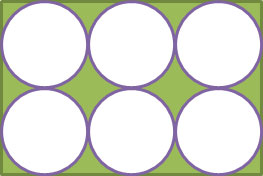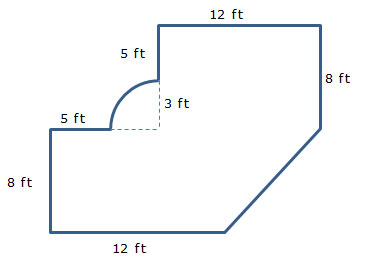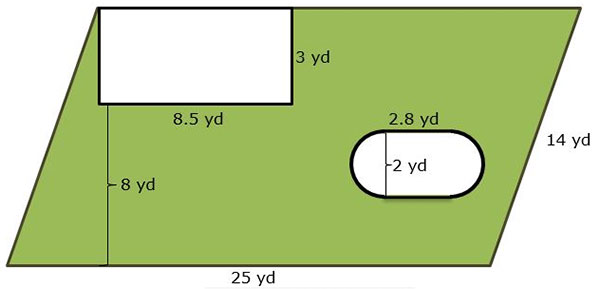In previous lessons or grades, you may have encountered a four-step problem solving process. Click on each step below.
In this section, you will step through the problem-solving process to solve a problem involving the area of a composite figure. Then, you will practice using the problem-solving process on your own.
Problem
Six circles are used to create an art deco design. The diameter of each circle is 8.5 centimeters, and they are arranged so that they fit exactly inside one rectangle, as shown in the figure below.
What is the approximate area of the green, or shaded region, in the art deco design?
To solve this problem, use the four-step problem-solving model.
Step 1: Read, understand, and interpret the problem.
- What information is presented?
Interactive popup. Assistance may be required.
Check Your Answer
- What is the problem asking you to find?
Interactive popup. Assistance may be required.
Check Your Answer
- What information do you not need?
Interactive popup. Assistance may be required.
Check Your Answer
|
Step 2: Make a plan.
|
Step 3: Implement your plan.
- What formulas do you need?
Interactive popup. Assistance may be required.
Check Your Answer
- What information can you interpret from the diagram, table, or other given information?
Interactive popup. Assistance may be required.
Check Your Answer
- Solve the problem.
Interactive popup. Assistance may be required.
Check Your Answer
|
Step 4: Evaluate your answer.
- Does your answer make sense?
Interactive popup. Assistance may be required.
Check Your Answer
- Did you answer the question that was asked?
Interactive popup. Assistance may be required.
Check Your Answer
- Are your units correct?
Interactive popup. Assistance may be required.
Check Your Answer
|
Pause and Reflect
Why is it important to evaluate your answer?
What are some ways to evaluate your answer?
Practice
- The floor plan for a family room is shown in the figure below.
What is the approximate area of the floor of the living room?
Interactive popup. Assistance may be required.
Need a hint?
- The diagram below shows a pasture that is shaped like a parallelogram. Inside the pasture is a rectangular shed and a trough that is shaped like a rectangle with two semicircles at each end. What is the approximate area of the shaded region, representing the amount of grass available for grazing? Round your answer to the nearest tenth.
 Use the grid below to record your answer. Type your answer in the boxes in front of and behind the decimal. Click inside each box to enter the numeral that belongs in the box. Click the bubble beneath the numeral to shade the bubble that matches the numeral. Incorrect portions of your answer will be shaded gray.
Use the grid below to record your answer. Type your answer in the boxes in front of and behind the decimal. Click inside each box to enter the numeral that belongs in the box. Click the bubble beneath the numeral to shade the bubble that matches the numeral. Incorrect portions of your answer will be shaded gray.








![]() Use the grid below to record your answer. Type your answer in the boxes in front of and behind the decimal. Click inside each box to enter the numeral that belongs in the box. Click the bubble beneath the numeral to shade the bubble that matches the numeral. Incorrect portions of your answer will be shaded gray.
Use the grid below to record your answer. Type your answer in the boxes in front of and behind the decimal. Click inside each box to enter the numeral that belongs in the box. Click the bubble beneath the numeral to shade the bubble that matches the numeral. Incorrect portions of your answer will be shaded gray.

